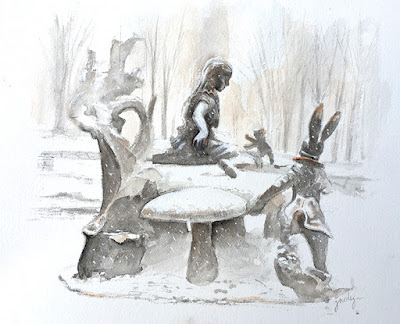
As outrageous and mad as these claims may appear, Dali’s obsession with the centre of the universe was genuine. He met Thom, was well aware of Einstein’s discoveries on the laws of physics and was specifically fascinated with quantum mechanics and how this would change our understanding of the universe. In 1958, he wrote in his "Anti-Matter Manifesto”: "In the Surrealist period I wanted to create the iconography of the interior world and the world of the marvellous, of my father Freud. Today the exterior world and that of physics, has transcended the one of psychology. My father today is Dr. Heisenberg" –the person who created the Heisenberg Uncertainty Principle. In seeing the connection between quantum physics and the mind and how it will supersede psychology, he was decades ahead of his and our time. Specifically, he not merely understand, but was able to visualise this in his surreal other world that he created on his canvases.
That makes Dali a visionary. Was he an alchemist? Dali met Uri Geller in Barcelona for a couple of days. Geller bent a gold fork in Dali’s hand; the latter took off to a room in his house, and locked himself in there for hours. For some, it is evidence of his madness. Perhaps, but when he emerged, he was holding a rock crystal sphere, which was his gift to Geller and which now sits proudly on the hood of Geller’s Cadillac, which is coated in bent spoons.
Dalí could indeed have been a true alchemist. In 1958, he painted a “meditative rose”. For an alchemist, mastery of divine geometry is the first step towards mastery over the elements. He noted that the rhinoceros horn grows according to a logarithmic spiral, which he then began to incorporate into his paintings. But the element he wanted to capture seems to have been Air. Before buying the castle Pubol, Dali had set his sight on Quermanco, between Figueras and Cadaques. In the end, the sale did not go through and he had to abandon his plan to use the castle as the stage for the installation of the Organ of Tramontane, a northerly wind. Dali wanted the organ's music to be heard by the people of the region. Locals believed the wind could drive people mad – and it seems Dali was about to test the validity of that claim.
He was fascinated by DNA and the hypercube; the latter, a four-dimensional cube, is featured in the painting Crucifixion (Corpus Hypercubus, 1954). On his return from New York, Dalí announced that he was going to paint a picture he himself termed as sensational: an exploding Christ, nuclear and hypercubic. It would be the first picture painted with a classical technique and an academic formula, but composed of cubic elements. To a reporter who asked him why he wanted to depict Christ exploding, he replied, "I don't know yet. First I have ideas, I explain them later. This picture will be the great metaphysical work of my summer."
Once completed, Dali defined it as "metaphysical, transcendent cubism”: "It is based entirely on the Treatise on Cubic Form by Juan de Herrera, Philip II's architect, builder of the Escorial Palace; it is a treatise inspired by Ars Magna of the Catalonian philosopher and alchemist, Raymond Lull. The cross is formed by an octahedral hypercube. The number nine is identifiable and becomes especially consubstantial with the body of Christ. The extremely noble figure of Gala is the perfect union of the development of the hypercubic octahedron on the human level of the cube. She is depicted in front of the Bay of Port Lligat. The most noble beings were painted by Velazquez and Zurbaran; I only approach nobility while painting Gala, and nobility can only be inspired by the human being."
Observers have noted that this work is actually a marriage between faith and science and sits rightly within the series of Dali’s 18 masterworks. This marriage by Dali has been labelled “Nuclear Mysticism”, in short, a marriage of Christian imagery with modern forms and depictions. Dali was hence a modern alchemist.


No comments:
Post a Comment